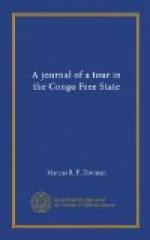Early in the morning of the 20th, we leave Matadi. The train consists of two engines, two open covered carriages for the second class passengers, who are mostly natives, a saloon and baggage wagon. The gauge is a very narrow one, so space is all-important, but the man who designed the chairs in the saloon must have exercised the most fiendish ingenuity to make them as uncomfortable as possible. There are six on each side, arranged in pairs with a small bracket table in between, and each one is on a pivot. The back is straight upright and the seat is of cane, cone-shaped, the highest point being in the centre. Now as the curves and gradients of the line are very sharp indeed, it is necessary to hold fast the whole time, to prevent slipping on to the floor. If one puts a foot on the opposite seat to steady oneself, it at once revolves, leaving the leg in mid air. However, we fix ourselves in as well as possible and enjoy the magnificent scenery. For a few hundred yards the line runs along the valley of the Congo and a good view of the lowest cataract is obtained, the brown water dashing over the rocks and throwing up spray which is converted into brilliant jewels by the youthful sun not yet an hour old. Then turning sharply to the right, the train runs up the valley of the Posu, a mountain torrent which rushes and roars through a narrow defile. Snorting angrily, the engines climb up this steep gradient, cross the river by an iron bridge and then groaning under the brakes, slide down into another valley. The main direction however, is upwards, and as the country opens out below, one gets a first impression of the enormity and grandeur of Central Africa. As far as the eye reaches, are ranges of hills, the Palabala Mountains crowned by a great cone which appears first on one side then the other, as we cork-screw our way up. The line indeed is a marvel of engineering construction, for a most difficult piece of country is traversed without a single tunnel and with very few cuttings and embankments. The length of the railway is, of course, very much greater than a straight line would be between the same points, for it frequently countermarches backwards and forwards up a hill side, and after a detour of perhaps a quarter of a mile, comes back to the same place, but thirty or forty feet higher up. The company which undertook the task of building the line met with many difficulties, but finished it at a cost of L3,000,000 and many native lives. It was built between the years 1891 and 1897 and the workmen were




